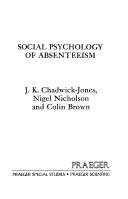| Listing 1 - 10 of 286 | << page >> |
Sort by
|
Book
ISBN: 0888190530 Year: 1982 Publisher: Montréal Québec Centre for Developing-Area Studies
Abstract | Keywords | Export | Availability | Bookmark
 Loading...
Loading...Choose an application
- Reference Manager
- EndNote
- RefWorks (Direct export to RefWorks)

ISBN: 0030566525 Year: 1982 Publisher: New York (N.Y.) : Praeger,
Abstract | Keywords | Export | Availability | Bookmark
 Loading...
Loading...Choose an application
- Reference Manager
- EndNote
- RefWorks (Direct export to RefWorks)
Book
ISBN: 2827102102 9782827102105 Year: 1982 Publisher: Fribourg: Éditions universitaires,
Abstract | Keywords | Export | Availability | Bookmark
 Loading...
Loading...Choose an application
- Reference Manager
- EndNote
- RefWorks (Direct export to RefWorks)
Book
ISBN: 0582295807 Year: 1982 Publisher: London : Longman,
Abstract | Keywords | Export | Availability | Bookmark
 Loading...
Loading...Choose an application
- Reference Manager
- EndNote
- RefWorks (Direct export to RefWorks)
Book
Year: 1982 Publisher: Cambridge, Mass. National Bureau of Economic Research
Abstract | Keywords | Export | Availability | Bookmark
 Loading...
Loading...Choose an application
- Reference Manager
- EndNote
- RefWorks (Direct export to RefWorks)
This paper argues that pensions are used as severance pay devices in an efficient compensation scheme. The major points of the study are: (1) Severance pay, which takes the form of higher pension values for early retirement, is widespread. (2) A major reason for the existence of pensions is the desire to provide an incentive mechanism that can also function as an efficient severance pay device. It is incorrect to think of pensions merely as a tax-deferred savings account. (3) The wage rates that older workers receive exceed their marginal products. This is evidenced by the fact that employers are willing to buy them out with higher pensions if they retire early. These conclusions are based upon examination of a data set which was generated as part of this study. That data set contains detailed information on 244 of the largest pension plans in the country, covering about 8 million workers.
Book
ISBN: 9282530906 Year: 1982 Publisher: Luxembourg Eurostat
Abstract | Keywords | Export | Availability | Bookmark
 Loading...
Loading...Choose an application
- Reference Manager
- EndNote
- RefWorks (Direct export to RefWorks)
Book
Year: 1982 Publisher: Cambridge, Mass. National Bureau of Economic Research
Abstract | Keywords | Export | Availability | Bookmark
 Loading...
Loading...Choose an application
- Reference Manager
- EndNote
- RefWorks (Direct export to RefWorks)
This paper examines the relative importance of timing and persistence elements in explaining cyclical fluctuations in labor supply. Data from the natural experiment provided by World War I1 and cross-sectional data on American local labor markets, as well as aggregate time-series data are used in the empirical work. We find little evidence that timing effects play an important role in labor market dynamics. The evidence suggests that views emphasizing persistence are more accurate, and that previous employment tends to raise the probability of subsequent employment.
Book
Year: 1982 Publisher: Cambridge, Mass. National Bureau of Economic Research
Abstract | Keywords | Export | Availability | Bookmark
 Loading...
Loading...Choose an application
- Reference Manager
- EndNote
- RefWorks (Direct export to RefWorks)
This paper formulates and tests the hypothesis that the categories unemployed and out of the labor force are behaviorally distinct labor force states. Our empirical results indicate that they are. In the empirically relevant range the exit rate from unemployment to employment exceeds the exit rate from out of the labor force to employment. This evidence is shown to be consistent with a simple job search model of productive unemployment with log concave wage offer distributions. We prove that if unemployed workers receive job offers more frequently than workers out of the labor force, and if wage offer distributions are log concave, the exit rate from unemployment to employment exceeds the exit rate from out of the labor force to employment.
Book
ISBN: 0904759482 Year: 1982 Publisher: London International defence and aid fund
Abstract | Keywords | Export | Availability | Bookmark
 Loading...
Loading...Choose an application
- Reference Manager
- EndNote
- RefWorks (Direct export to RefWorks)
Book
ISBN: 3518111310 Year: 1982 Publisher: Frankfurt am Main Suhrkamp
Abstract | Keywords | Export | Availability | Bookmark
 Loading...
Loading...Choose an application
- Reference Manager
- EndNote
- RefWorks (Direct export to RefWorks)
| Listing 1 - 10 of 286 | << page >> |
Sort by
|

 Search
Search Feedback
Feedback About UniCat
About UniCat  Help
Help News
News